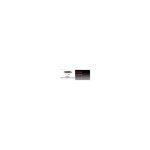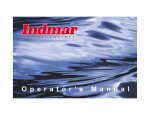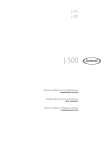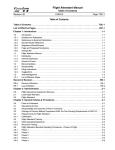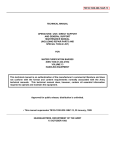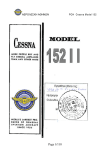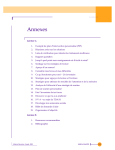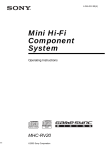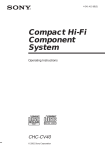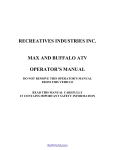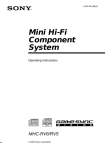Download Alpi Aviation Pioneer 200 Aircraft Technical data
Transcript
PIONEER 200 Aircraft FLIGHT MANUAL __________________________________________ Document N° F2-1.0/R80/F/EU Dated 20-04-2002 Cover page MANUFACTURER : ALPI AVIATION S.r.l. Address : City : Country : Via dei Templari, 24 33080 San Quirino (PN) Italy Web Site : www.alpiaviation.com Telephone: E - mail : +39 0434 37 04 96 [email protected] AIRCRAFT TYPE & MODEL Type : Pioneer Model : 200 Aircraft Mark : Aircraft S/N : By : www.aeroprogetti.net Pioneer 200 Flight Manual Document N° : Section: 0 F2-1.0/R80/F/EU TABLE OF CONTENTS SECTION General 1 Limitations 2 Emergency Procedures 3 Normal Procedures 4 Performance 5 Weight and Balance Statement 6 This page will change with all revision issues REVISION : By :www.aeroprogetti.net 0 Dated: 20-04-2002 Sect : 0 -Page: 1 of 8 Document N° : Pioneer 200 Flight Manual Section: 0 F2-1.0/R80/F/EU AMENDMENT RECORD SHEET Revision No. Page(s) affected 0 All pages Signature. Date of Incorporation 20-03-02 This page will change with all revision issues REVISION : By :www.aeroprogetti.net 0 Dated: 20-04-2002 Sect : 0 -Page: 2 of 8 Document N° : Pioneer 200 Flight Manual Section: 0 F2-1.0/R80/F/EU INTRODUCTION This Flight Manual applies only to the particular aircraft identified by the registration marking and serial number on the Cover Page and contains the airworthiness limitations and essential operating data for this aircraft. The Flight Manual shall be carried in the aircraft on all flights. Special operations requiring additional limitations and instructions are listed in the "Supplements Section" and this section shall be consulted before undertaking any such operations. For operating information not included in this manual, reference should be made to the appropriate operations or manufacturer's manuals. The pilot in command the aircraft shall comply with all requirements, procedures and limitations with respect to the operation of the aircraft set out in the Flight Manual for the aircraft. Amendments shall be issued by Alpi Aviation as necessary and will take the form of replacement pages, with the changes to the text indicated by a vertical line in the margin together with the amendment date at the bottom of the page. Interim/Temporary amendments may be issued in the same manner and are to be inserted as directed. These amendments will be issued on coloured pages and will take precedence over the stated affected page. It is the owner's responsibility to incorporate in this manual all such amendments, and to enter the date of incorporation and his signature on the appropriate Amendment Record Sheet. No entries or endorsements may be made to this Flight Manual except in the manner and by persons authorised for the purpose. REVISION : By :www.aeroprogetti.net 0 Dated: 20-04-2002 Sect : 0 -Page: 3 of 8 Document N° : Pioneer 200 Flight Manual Section: 0 F2-1.0/R80/F/EU REVISIONS It is the responsibility of the owner to maintain this Manual in a current status when it is being used for operational purposes. Owners should contact Alpi Aviation S.r.l. whenever the revision status of their Manual is in question. A revision bar will extend the full length of new or revised text and/or illustrations added on new or presently existing pages. This bar will be located adjacent to the applicable revised area on the outer margin of the page. All revised pages will carry the revision number and the date on the applicable page. The following List of Effective Pages provides the dates of issue for original and revised pages, and a listing of all pages in the Manual. Pages affected by the current revision are indicated by an asterisk (*) preceding the pages listed. REVISION : By :www.aeroprogetti.net 0 Dated: 20-04-2002 Sect : 0 -Page: 4 of 8 Pioneer 200 Flight Manual Document N° : Section: 0 F2-1.0/R80/F/EU LIST OF EFFECTIVE PAGES Page 0-1 0-2 0-3 0-4 0-5 0-6 0-7 0-8 1-1 1-2 1-3 1-4 1-5 1-6 The dates of issue for original & revised pages are: Rev. Date Page Rev. Date Page Section 0 Section 3 0 20-04-02 3-1 0 20-04-02 5-1 0 20-04-02 3-2 0 20-04-02 5-2 0 20-04-02 3-3 0 20-04-02 0 20-04-02 3-4 0 20-04-02 0 20-04-02 3-5 0 20-04-02 0 20-04-02 3-6 0 20-04-02 0 20-04-02 3-7 0 20-04-02 0 20-04-02 3-8 0 20-04-02 3-9 0 20-04-02 6-1 3-10 0 20-04-02 6-2 3-11 0 20-04-02 6-3 3-12 0 20-04-02 6-4 3-13 0 20-04-02 3-14 Section 1 0 20-04-02 0 20-04-02 0 20-04-02 0 20-04-02 0 20-04-02 0 20-04-02 4-1 4-2 4-3 4-4 4-5 4-6 4-7 4-8 4-9 Section 2 2-1 0 20-04-02 4-10 2-2 0 20-04-02 4-11 2-3 0 20-04-02 4-12 2-4 0 20-04-02 4-13 2-5 0 20-04-02 4-14 2-6 0 20-04-02 4-15 2-7 0 20-04-02 4-16 2-8 0 20-04-02 4-17 4-18 This page will change with all revision issues REVISION : By :www.aeroprogetti.net 0 Rev. Date Section 5 0 20-04-02 0 20-04-02 Section 6 0 20-04-02 0 20-04-02 0 20-04-02 0 20-04-02 Section 4 0 20-04-02 0 20-04-02 0 20-04-02 0 20-04-02 0 20-04-02 0 20-04-02 0 20-04-02 0 20-04-02 0 20-04-02 0 20-04-02 0 20-04-02 0 20-04-02 0 20-04-02 0 20-04-02 0 20-04-02 0 20-04-02 0 20-04-02 0 20-04-02 Dated: 20-04-2002 Sect : 0 -Page: 5 of 8 Pioneer 200 Flight Manual Document N° : Section: 0 F2-1.0/R80/F/EU DEFINITIONS AIRFIELD PRESSURE ALTITUDE The Airfield Pressure Altitude is that altitude registered at the surface of the aerodrome by an altimeter with the pressure subscale set to 1013 millibars INDICATED AIRSPEED (I.A.S.) Indicated airspeed, which is the reading obtained from an airspeed indicator having no calibration error. TAKEOFF SAFETY SPEED The Takeoff Safety Speed is a speed chosen to ensure that adequate control will exist under all conditions, including turbulence and sudden and complete engine failure, during the climb after takeoff. LANDING SAFETY SPEED The Landing Safety Speed is the speed chosen to ensure that adequate control will exist under all conditions, including turbulence, to carry out normal flare and touchdown. NORMAL OPERATING SPEED This speed shall not normally be exceeded. Operations above the Normal Operating Speed shall be conducted with caution and only in smooth air. Va Maximum for manoeuvres involving an approach to stall conditions or full application of the primary flight controls. MANOEUVRING SPEED KCAS KNOTS CALIBRATED AIRSPEED Indicated airspeed corrected for position and instrument error and expressed in knots. KCAS is equal to KTAS in standard atmosphere at sea level KIAS KNOTS INDICATED AIRSPEED The speed shown on the airspeed indicator and expressed in knots. KTAS The airspeed expressed in knots relative to undisturbed air which is KCAS corrected for altitude and temperature. KNOTS TRUE AIRSPEED V fe MAXIMUM FLAP EXTENDED SPEED The highest speed permissible with wing flaps in the prescribed extended position. V no MAXIMUM STRUCTURAL CRUISING SPEED The speed that should not be exceeded except in smooth air, and then only with caution. V ne NEVER EXCEED SPEED The speed limit that may not be exceeded at any time. V s0 STALLING SPEED The stall speed or minimum steady flight speed at which the airplane is controllable in a specified configuration. V so STALLING SPEED The stall speed or minimum steady flight speed at which the airplane is controllable in the landing configuration at the most forward centre of gravity. LANDING CONFIGURATION REVISION : By :www.aeroprogetti.net 0 Dated: 20-04-2002 Sect : 0 -Page: 6 of 8 Pioneer 200 Flight Manual Document N° : Section: 0 F2-1.0/R80/F/EU V x BEST ANGLE-OF-CLIMB SPEED The speed which results in the greatest gain of altitude in a given horizontal distance. Vy The speed which results in the greatest gain in altitude in a given time. BEST RATE-OF-CLIMB SPEED METEOROLOGICAL TERMINOLOGY OAT OUTSIDE AIR TEMPERATURE The free static air temperature. It is expressed in either degrees Celsius or degrees Fahrenheit. STANDARD TEMPERATURE Standard Temperature is 15 degrees C at sea level pressure altitude. PRESSURE ALTITUDE The altitude read from the an altimeter when the altimeter's barometric scale has been set to 1013 mb (29.92 inches of mercury). ENGINE POWER TERMINOLOGY BHP BRAKE HORSEPOWER The power developed by the engine. RPM REVOLUTIONS PER MINUTE Engine speed. STATIC RPM The engine speed attained during a full-throttle engine runup when the airplane is on the ground and stationary. AIRPLANE PERFORMANCE AND FLIGHT PLANNING TERMINOLOGY MAXIMUM CROSSWIND VELOCITY The velocity of the crosswind component for which adequate control of the airplane during takeoff and landing was actually demonstrated during the certification tests. The value shown is limiting. USEABLE FUEL The fuel available for flight planning UNUSABLE FUEL The quantity of fuel that cannot be safely used in flight LPH LITRES PER HOUR NMPL LITRE The amount of fuel ( in litres ) consumed per hour NAUTICAL MILES PER g The distance ( in nautical miles ) which can be expected per litre of fuel consumed at a specific engine power setting and/or flight configuration. The acceleration due to gravity. REVISION : By :www.aeroprogetti.net 0 Dated: 20-04-2002 Sect : 0 -Page: 7 of 8 Pioneer 200 Flight Manual Document N° : Section: 0 F2-1.0/R80/F/EU WEIGHT AND BALANCE TERMINOLOGY STATION Only two load stations are specified: ie Seat Station which is the centre of the fixed seats and Fuel Station which is the centre of the fixed fuel tank. C.G. The point at which an airplane, or equipment, would balance if suspended. CENTRE OF GRAVITY C.G. LIMITS The extreme centre of gravity locations within which the airplane must be operated at a given weight. STANDARD EMPTY WEIGHT The weight of a standard airplane, including unusable fuel, full operating fluids and full engine oil. BASIC EMPTY WEIGHT The standard empty weight plus the weight of optional equipment. USEFUL LOAD - The difference between ramp weight and the basic empty weight. MTOW MAXIMUM TAKEOFF WEIGHT The maximum weight approved for the start of the takeoff run. REVISION : By :www.aeroprogetti.net 0 Dated: 20-04-2002 Sect : 0 -Page: 8 of 8 Pioneer 200 Flight Manual Document N° : Section: 1 General F2-1.0/R80/F/EU Section1 - General Table of Contents 1.1. AIRCRAFT THREE VIEW DRAWING 2 1.2. TECHNICAL DATA 4 1.2.1. ENGINE 4 1.2.2. PROPELLER 4 1.2.3. APPROVED FUEL TYPES AND GRADES 4 1.2.4. FUEL CAPACITY 4 1.2.5. APPROVED OIL GRADES 5 1.2.6. COOLANT 5 1.2.7. OIL CAPACITY 5 1.2.8. TYRE INFLATION PRESSURES 5 REVISION : 0 Dated: 20-04-2002 Sect : 1 -Page: 1 of 6 Document N° : Pioneer 200 Flight Manual Section: 1 General F2-1.0/R80/F/EU 1.1. AIRCRAFT THREE VIEW DRAWING REVISION : 0 Dated: 20-04-2002 Sect : 1 -Page: 2 of 6 Document N° : Pioneer 200 Flight Manual Section: 1 General F2-1.0/R80/F/EU Ground Turning Radius = 6 metres. REVISION : 0 Dated: 20-04-2002 Sect : 1 -Page: 3 of 6 Pioneer 200 Flight Manual Document N° : Section: 1 General F2-1.0/R80/F/EU 1.2. TECHNICAL DATA 1.2.1. ENGINE Manufacturer: ROTAX GmbH Aircraft Engine Type: 1.2.2. 912 UL Series liquid cooled PROPELLER Manufacturer: TONINI Type: Fixed Pitch Wooden GT 166X142 Diameter: 166 cm Pitch: 142 cm 1.2.3. APPROVED FUEL TYPES AND GRADES -UNLEADED MOGAS (98 Octane or greater - 90 RON or greater) -100 LL or 100/130 grade aviation gasoline (only for short utilization time, with carbon level inspection) 1.2.4. FUEL CAPACITY Total: 54 Litres Useable 50 Litres REVISION : 0 Dated: 20-04-2002 Sect : 1 -Page: 4 of 6 Pioneer 200 Flight Manual Document N° : Section: 1 General F2-1.0/R80/F/EU 1.2.5. APPROVED OIL GRADES Motorcycle oil of a registered brand with gear additive Specification Exemples : API classification "SJ" or "SG" Shell - Advance VSX 4 (SAE 20W-40) Castrol - Syntetic Blend (SAE 5W-50) Shell - Synthetic Blend (SAE 10W-30) For temp. Above and belove stated check Rotax engine manuals For AVGAS use chech Rotax engine manuals 1.2.6. COOLANT Antifreeze concentrate with additives against corrosion should be used with 50% water in normal condition, and down 20% water in cold environment. Capacity Overflow or filler tank 1.2.7. Max 2,3 litres Max 0,2 lt Min 2,2 litres Min 0,1 lt OIL CAPACITY Sump capacity is : 3 Litres 1.2.8. REVISION : TYRE INFLATION PRESSURES Standard Mains: bar = 2.2 (psi = 32.3) Nose: bar = 2.2 (psi = 32.3) 0 Dated: 20-04-2002 Sect : 1 -Page: 5 of 6 Document N° : Pioneer 200 Flight Manual Section: 1 General F2-1.0/R80/F/EU INTENTIONALLY LEFT BLANK REVISION : 0 Dated: 20-04-2002 Sect : 1 -Page: 6 of 6 Pioneer 200 Flight Manual Document N° : Section: 2 Limitations F2-1.0/R80/F/EU Section 2 - Limitations Table of Contents Table of contents 1 2.1. Introduction 2 2.2. Type of operation 2 2.3. Airspeed limitations 2 2.4. Weights and loading 3 2.5. Centre of gravity limits 3 2.6. Powerplant limitations 4 2.7. Other limitations 4 2.7.1. Authorised manoeuvres and limitations 4 2.7.2. Smoking 4 2.7.3. Max. air temperature for operations 5 2.7.4. Flights with doors removed 5 2.7.5. Maximum number of occupants 5 2.7.6. Maximum crosswind velocity 5 2.8. Placards REVISION : 0 6 Dated: 20-04-2002 Sect : 2 -Page: 1 of 8 Pioneer 200 Flight Manual Document N° : Section: 2 Limitations F2-1.0/R80/F/EU 2.1. INTRODUCTI0N Section 2 includes operating limitations, instrument markings and basic placards necessary for the safe operation of the airplane, its engine, standard systems and standard equipment. Observance of these operating limitations is required. The aeroplane shall be operated so that the limitations and instructions included in this section are observed. 2.2. TYPE OF OPERATION VFR by Day see also para 2.7.1. Authorised mamoeuvres and limitations. 2.3. AIRSPEED LIMITATIONS Airspeed limitations and their operational significance are shown below. SPEED Km/h REMARKS V ne Never exceed speed 240 Do not exceed this speed in any operation. V no Maximum structural cruising speed 215 Do not exceed this speed except in smooth air, and then only with caution. Va 180 Do not make full or abrupt control movements above this speed. 100 Do not exceed this speed with flaps down. Manoeuvring speed V fe Maximum flap extended speed Vso Stall speed REVISION : 63 0 Whit extended flaps Dated: 20-04-2002 Sect : 2 -Page: 2 of 8 Pioneer 200 Flight Manual Document N° : Section: 2 Limitations F2-1.0/R80/F/EU Airspeed Indicator Markings and their operational significance are shown below. MARKING Km/h SIGNIFICANCE Range White Arc 65 - 100 Full-flap operating range. Lower limit is max. weight Vso in landing configuration. Upper limit is max. speed permissible with flaps extended. Green Arc 100 - 180 Normal operating range. Lower limit is Take-off Safety speed. Upper limit is max. structural cruising speed. Yellow Arc 180 - 215 Operations must be conducted with caution and only in still air. Red Line 240 2.4. 2.5. Vne WEIGHTS and LOADING Maximum takeoff weight 450 Kg Maximum landing weight 450 Kg CENTRE OF GRAVITY LIMITS Forward : Aft : 600 mm aft of datum up to & including 350 Kg 685 mm aft of datum @ 450 Kg. Variation is linear between 350 & 450 kg. 768 mm aft of datum at all weights Fire-guard bulcked Leveling Means: Spirit Level placed lateral canopy strut Longitudinal Spirit Level crossing canopy Lateral Datum : REVISION : 0 Dated: 20-04-2002 Sect : 2 -Page: 3 of 8 Pioneer 200 Flight Manual Document N° : Section: 2 Limitations F2-1.0/R80/F/EU 2.6. POWERPLANT LIMITATIONS Instrument Yellow Arc Green Arc Red Radial Line/Arc Tachometer 1000 - 1400RPM 1400 - 5500 RPM 5800 RPM Oil Temp. 50° - 90° C 90o - 110oC (190° - 230° F) 140° C (120° - 190° F) Oil Pressure (285° F) 0,8 - 2,0 bar 2,0 - 5,0 bar 7 bar (12 - 29 psi) (29 - 73 psi) (102 psi) 90° - 150° C 150° C (190° - 300° F) (300° F) Cylinder Head Temperature Minimum Oil Temperature for Takeoff Needle must be seen to move off the stop before Takeoff Minimum Oil Pressure in Level Flight or climb 2 bar (29 psi) In Descent 0,8 bar (12 psi) Maximum Cylinder Head Temperature 150° C (300° F) Maximum RPM for all operations 5800 Full Throttle Static RPM Not Above 5500 Not Under 5300 2.7. OTHER LIMITATIONS 2.7.1. AUTHORISED MANOEUVRES AND ASSOCIATED LIMITATIONS Acrobatic maneuver, including spins, are not permitted. 2.7.2. SMOKING REVISION : 0 Dated: 20-04-2002 Sect : 2 -Page: 4 of 8 Document N° : Pioneer 200 Flight Manual Section: 2 Limitations F2-1.0/R80/F/EU Prohibited. 2.7.3. MAXIMUM AIR TEMPERATURE FOR OPERATIONS 40o C for takeoff at gross weight. 2.7.4. MAXIMUM PERMISSIBLE NUMBER OF OCCUPANTS Two (including Pilot). 2.8 MAXIMUM CROSSWIND VELOCITY 25 Km/h REVISION : 0 Dated: 20-04-2002 Sect : 2 -Page: 5 of 8 Pioneer 200 Flight Manual Document N° : Limitations F2-1.0/R80/F/EU 2.9. Section: 2 PLACARDS Cockpit Placards General WARNING • Users of this aircraft do so at their own risk • This aircraft must be flown in acc ordance with the Owners Manual • Aerobatics Including spins are PROHIBITED • Noise Level at Full Power exceeds 90 dB (A Ear Protection Should be worn AIRCRAFT TYPE : PIONEER 200 Designed and Manufactured in Italy by ALPI AVIATION Srl Pordenone FLIGHT MANUAL BAGGAGEMAX WEIGHT 10 Kg DO NOT LOAD AFT OF THIS POINT LOADING LIMITATIONS 1. The maximum gross weight of the aircraft is not to exceed 450 kg). 2. All baggage must be stowed either on the passenger seat, or on rear seats 3. Pilots must use the Load and Balance given in Section 6 of the Owner’s Manual to check the trim. Cockpit Controls NOSE DOWN NEUTRAL TRIM FUEL NOSE UP OFF ON REVISION : 0 Dated: 20-04-2002 Sect : 2 -Page: 6 of 8 Document N° : Pioneer 200 Flight Manual Section: 2 Limitations F2-1.0/R80/F/EU External Fuselage STATIC VENT KEEP CLEAR EARTH ON No step Tyre pressure 32.3 Psi (2.2 Bar) FUEL AVGAS 100LL (See Sect 1) or UNLEADED MOGAS 98 Octane or Higher 54 Lt capacity Earth on Post REVISION : 0 Dated: 20-04-2002 Sect : 2 -Page: 7 of 8 Document N° : Pioneer 200 Flight Manual Section: 2 Limitations F2-1.0/R80/F/EU INTENTIONALLY LEFT BLANK REVISION : 0 Dated: 20-04-2002 Sect : 2 -Page: 8 of 8 Pioneer 200 Flight Manual Document N° : Section: 3 Emergency Procedures F2-1.0/R80/F/EU Section 3 - Emergency Procedures Table of Contents 3.1. INTRODUCTION 2 3.2. AIRSPEEDS FOR EMERGENCY OPERATION 2 3.3. OPERATIONAL CHECKLISTS 3 3.3.1. . . . . ENGINE FAILURES ENGINE FAILURE DURING TAKEOFF RUN 3 ENGINE FAILURE IMMEDIATELY AFTER TAKEOFF 3 ENGINE FAILURE DURING FLIGHT AIRSTART & LIMITATIONS 3 3 4 3.3.2. . . . . FIRES FIRE DURING START ON GROUND ENGINE FIRE IN FLIGHT ELECTRICAL FIRE IN FLIGHT CABIN FIRE 5 5 6 6 7 3.3.3. . . . . FORCED LANDING EMERGENCY LANDING WITHOUT ENGINE POWER PRECAUTIONARY LANDING WITH ENGINE POWER DITCHING LANDING WITH A FLAT MAIN TYRE 7 7 8 8 10 3.3.4. ELECTRICAL POWER SUPPLY SYSTEM MALFUNCTIONS 10 3.3.5. MAXIMUM GLIDE 11 3.3.6. RECOVERY FROM AN INADVERTENT SPIN 11 OTHER PROCEDURES 11 3.4.1. CARBURETTOR HEAT 12 3.4.2. 12 IGNITION MALFUNCTION 3.4.3. LOW OIL PRESSURE 3.4. REVISION : 0 Dated: 20-04-2002 13 Sect : 3 -Page: 1 of 14 Pioneer 200 Flight Manual Document N° : Section: 3 Emergency Procedures F2-1.0/R80/F/EU 3.1. INTRODUCTION Section 3 provides checklist and other procedures for coping with emergencies that may occur. Emergencies caused by aeroplane malfunctions are rare if proper preflight inspections and maintenance are practiced. En route weather emergencies can be minimized or eliminated by careful flight planning and good judgement when unexpected weather is encountered. However, should an emergency arise, the basic guidelines outlined in this section should be considered and applied as necessary to correct the problem. 3.2. AIRSPEEDS FOR EMERGENCY OPERATION Engine Failure After Takeoff 90-100 Km/h Manoeuvring Speed ( at all weights) 180 Km/h Maximum Glide Distance, Still Air 110 Km/h 1 Precautionary Landing Approach with Engine Power 100 Km/h Landing Approach Without Engine Power: landing Flaps Up 150 Km/h landing Flaps Down 90 Km/h Note1 : A slightly higher speed may give better distance over the ground if gliding into wind; a slightly lower speed if gliding downwind. REVISION : 0 Dated: 20-04-2002 Sect : 3 -Page: 2 of 24 Pioneer 200 Flight Manual Document N° : Section: 3 Emergency Procedures F2-1.0/R80/F/EU 3.3. OPERATIONAL CHECKLISTS 3.3.1. ENGINE FAILURES ENGINE FAILURE DURING TAKEOFF RUN 1 Throttle Idle 2 Brakes Apply 3 Ignition Switches OFF 4 Master Switch OFF ENGINE FAILURE IMMEDIATELY AFTER TAKEOFF 1 Move the control stick FORWARD to mantain Airspeed : 90-100 Km/h 2 Fuel Shutoff Valve OFF 3 Ignition Switches OFF 4 Wing Flaps as required 5 Master Switch OFF ENGINE FAILURE DURING FLIGHT 1 Airspeed Best Glide Angle 110 Km/h (1) 2 If it is Carburetor Heat ON 3 Fuel Shutoff Valve ON 4 Fuel Pump ON Ignition Switches ON 5 1 Note : A slightly higher speed may give better distance over the ground if gliding into wind; a slightly lower speed if gliding downwind REVISION : 0 Dated: 20-04-2002 Sect : 3 -Page: 3 of 34 Pioneer 200 Flight Manual Document N° : Section: 3 Emergency Procedures F2-1.0/R80/F/EU AIRSTART & LIMITATIONS In the event that the engine is stopped during flight, it may be restarted by application of fuel & ignition, provided that the propeller is still windmilling. The following procedure addresses only airstarts by use of the Starter Motor. IMPORTANT DO NOT depress starter button while propeller is rotating. 1 Ignition Switches OFF 2 Cabin Clear 3 Increase angle of attack & reduce speed (up to & including a stall) until propeller stops rotation 4 Establish Glide 110 Km/h 5 Fuel ON 6 Fuel Pump ON 7 Master ON 8 Ignition Switches ON 9 Starter Button Depress 10 Throttle Open 11 Repeat as necessary: Ensuring propeller has stopped rotation before each restart attempt. Note : The engine cools quickly with the propeller stopped. Choke may need to be used to start if time between restart is longer. After restart not RPM max power. REVISION : 0 Dated: 20-04-2002 Sect : 3 -Page: 4 of 44 Pioneer 200 Flight Manual Document N° : Section: 3 Emergency Procedures F2-1.0/R80/F/EU 3.3.2. FIRE FIRE DURING START ON GROUND 1 Cranking CONTINUE to get a start that would suck the flames and accumulated fuel through the carburettor and into the engine. If engine starts, 2 Power 2500 RPM 3 Fuel OFF & allow engine to empty carburettor 4 Engine Inspect for damage If engine fails to start, 5 Cranking CONTINUE in an effort to obtain a start. If no start in 15 seconds : Shut off fuel & continue to crank for another 15 seconds. 6 Fire Extinguisher Obtain (have ground attendant sobtain if not installed). 7 Engine SECURE. A Master Switch OFF B Ignition Switch OFF C Fuel Pump Switch OFF D Fuel Shutoff Valve OFF 8 Fire Extinguish using fire extinguisher, wool blanket, or dirt. 9 Fire Damage Have authorised people inspect, repair damage or replace damaged components or wiring before conducting another flight. REVISION : 0 Dated: 20-04-2002 Sect : 3 -Page: 5 of 54 Pioneer 200 Flight Manual Document N° : Section: 3 Emergency Procedures F2-1.0/R80/F/EU ENGINE FIRE IN FLIGHT 1 Throttle CLOSED 2 Fuel Shutoff Valve OFF 3 Mag Switches OFF 4 Master Switch OFF 5 Fuel Pump Switch OFF 6 Cabin Air OFF 7 Airspeed 110 Km/h (if fire is not extinguished, increase glide speed to find an airspeed which will provide an incombustible mixture). 8 Forced Landing Execute (as described in Emergency Landing Without Engine Power). ELECTRICAL FIRE IN FLIGHT 1 Master Switch OFF 2 All Other Switches OFF 3 Vents/cabin air (*) OPEN If fire appears out and electrical power is necessary for continuance of flight: 4 Master Switch ON 5 Fuses CHECK for faulty circuit, DO NOT reset or replace. 6 Radio/Electrical Switches ON one at a time, with delay after each until short circuit is localised. 7 Land as soon as possible to inspect for damage REVISION : 0 Dated: 20-04-2002 Sect : 3 -Page: 6 of 64 Pioneer 200 Flight Manual Document N° : Section: 3 Emergency Procedures F2-1.0/R80/F/EU CABIN FIRE 1 Master Switch OFF 2 Vents/Cabin Air (*) OPEN 3 Land as soon as possible to inspect for damage. (*) Have been demonstrated possibility to open canopy in flight up to 100 mm slot, manually blocked in this position. If released, the canopy will close by aerodynamic force. 3.3.3. FORCED LANDINGS AIRFIELD OR AIRSTRIP EMERGENCY LANDING WITHOUT ENGINE POWER 1 Airspeed 100-105 Km/h (flaps UP) Approach 90 Km/h (flaps DOWN) 2 Fuel Shutoff Valve OFF 3 Fuel Pump OFF 4 Ignition Switches OFF 5 Wing Flaps as required 6 Master Switch OFF Note : IF FIRE Release canopy and seat belts just before touchdown. Cushion face at touchdown with folded coat or cushion 7 Touchdown Slightly Tail Low 8 Brakes as required REVISION : 0 Dated: 20-04-2002 Sect : 3 -Page: 7 of 74 Pioneer 200 Flight Manual Document N° : Section: 3 Emergency Procedures F2-1.0/R80/F/EU AIRFIELD OR AIRSTRIP PRECAUTIONARY LANDING WITH ENGINE POWER 1 Airspeed 100-105 Km/h 2 Wing Flaps 1st Stage 3 Fuel Pump ON 4 Selected Field FLY OVER Note terrain and obstructions 5 Radio and Electrical Switches ON 6 Wing Flaps FULL ( on final approach ) 7 Airspeed 90 Km/h Note : IF FIRE Release canopy and seat belts just before touchdown. Cushion face at touchdown with folded coat or cushion 8 Touchdown Slightly Tail Low 9 Ignition Switch OFF 10 Brakes as required OPEN FIELD FORCED LANDING WITHOUT ENGINE POWER 1 Airspeed 105-110 Km/h 2 Flap and gears UP 3 Fuel Shutoff Valve OFF 4 Fuel Pump OFF 5 Ignition Switches OFF 6 Master Switch OFF REVISION : 0 Dated: 20-04-2002 Sect : 3 -Page: 8 of 84 Pioneer 200 Flight Manual Document N° : Section: 3 Emergency Procedures F2-1.0/R80/F/EU 7 Note : IF FIRE Release canopy and seat belts just before touchdown. Cushion face at touchdown with folded coat or cushion Touchdown level attitude OPEN FIELD FORCED LANDING WITH ENGINE POWER 1 Airspeed 100-110 Km/h 2 Wing Flaps 1st Stage 3 Fuel Pump ON 4 Selected Field FLY OVER Note terrain and obstructions 5 Radio and Electrical Switches ON 6 Flaps UP ( on final approach ) 7 Airspeed 110 Km/h 8 If time allows put propeller in orizontal position with Ignition Switch Note : IF FIRE 9 OFF Release canopy and seat belts just before touchdown. Cushion face at touchdown with folded coat or cushion Touchdown level attitude DITCHING (FORCED WATER LANDING) 1 Radio REVISION : Transmit MAYDAY on area frequency, giving location and intentions. 0 Dated: 20-04-2002 Sect : 3 -Page: 9 of 94 Pioneer 200 Flight Manual Document N° : Section: 3 Emergency Procedures F2-1.0/R80/F/EU 2 Heavy Objects SECURE 3 Approach High winds, heavy seas INTO wind. Light winds, heavy swells Parallel to Swells 4 Wing Flaps UP 5 Power establish 15 m/min (50ft/min) descent at 90 Km/h 6 Canopy Just before splashdown open canopy 7 Touchdown level attitude 8 Face Cushion at touchdown with folded coat or cushion 9 Aeroplane Release seat belts. Evacuate through canopy. 10 Lifevests Inflate 3.3.4. LANDING WITH A FLAT MAIN TYRE 1 Wing Flaps FULL 2 Approach Normal 3 Touchdown GOOD TYRE FIRST hold aeroplane off flat tyre as long as possible with aileron control. 3.3.5. ELECTRICAL POWER SUPPLY SYSTEM MALFUNCTIONS REVISION : 0 Dated: 20-04-2002 Sect : 3 -Page: 10 of 104 Pioneer 200 Flight Manual Document N° : Section: 3 Emergency Procedures F2-1.0/R80/F/EU Refit magneto-thermal fuse, if again fails continue to next airport and inspect or replace. Run, after, the engine; if the fuse again fails rectify before continuing flight. 3.3.6. MAXIMUM GLIDE - For Minimum Rate of Sink: 110 KM/H - For Maximum Distance in Still Air: 110 Km/h - To maximize distance achieved into wind, increase glide speed by approximately 1/3 of wind velocity. - Glide performance will be improved (if time permits) by stopping propeller windmilling 3.3.7. RECOVERY FROM AN INADVERTENT SPIN While inadvertent spins are unlikely, should this occur, proceed as follows: 1 Throttle IDLE 2 Ailerons NEUTRALISE 3 Rudder Opposite direction of spin and HOLD ON 4 Just AFTER rudder reaches the stop, move the control stick FORWARD far enough to break the stall. Full down elevator may be required at aft centre of gravity loadings to assure optimum recoveries. 5 HOLD these control inputs until rotation stops. Premature relaxation of control inputs may extend the recovery. 6 3.4. As rotation stops, neutralise rudder and make a smooth recovery from the resulting dive OTHER PROCEDURES REVISION : 0 Dated: 20-04-2002 Sect : 3 -Page: 11 of 114 Pioneer 200 Flight Manual Document N° : Section: 3 Emergency Procedures F2-1.0/R80/F/EU 3.4.1. CARBURETTOR HEAT (IF APPLICABLE) This system serves to prevent the formation of ice within the carburettor, where it primarily forms on the throttle plates in such a manner as to obstruct the airflow, with resultant eventual engine stoppage. Vaporisation of the fuel & expansion of air through the carburettor cause a cooling of the mixture, which can be as much as 15 degrees C below the temperature of the ambient air. This permits moisture in the air to condense and form ice. The first indications of icing are an RPM drop or a drop in manifold pressure. Progressive icing will cause obstruction of the carburettor, which manifests itself in the form of a rough running engine. During this time the smaller volume of air aspirated has richened the mixture. Ice can form more rapidly with partial throttle, due to the lower pressure in the carburettor. At full throttle, the danger is lessened somewhat. Therefore, carburettor heat is not to be used during takeoff or climb, also because it creates a small power loss. IMPORTANT During descent & approach, the carburettor heat should be used because low power settings create low pressures in the induction manifold. In case of a go-around, turn the carburettor heat OFF. Prolonged use of carburettor heat with more than 80% power applied could provoke detonation. When using Carburettor Heat, pull knob to FULL ON. DO NOT use partial Carburettor Heat. Carburetor icing can occur when on the ground, particularly when the aircraft and engine have become damp overnight. Check carburetor heat during power check as normal, prior to lining up on runway close the throttle completely, if a low tick over or engine stoppage occurs ice is present so burn it off with twenty seconds of heat and then test again prior to take off. 3.4.2. IGNITION MALFUNCTION A sudden engine roughness or misfiring is usually evidence of ignition problems. Switching from both ON to alternately switching each system OFF will identify which system is malfunctioning. Switch to the good system and proceed to the nearest airport for repairs. REVISION : 0 Dated: 20-04-2002 Sect : 3 -Page: 12 of 124 Pioneer 200 Flight Manual Document N° : Section: 3 Emergency Procedures F2-1.0/R80/F/EU 3.4.3. LOW OIL PRESSURE 1 A rapid drop from normal indicated pressure to indication "0” Action Observe for smell of oil Open cabin air vents Observe for signs of spilt oil on cowls, windscreen, wing surface. If strong smell of oil and oil appearing on airframe, reduce power to minimum to sustain level flight and proceed to nearest landing area. Be prepared to make an emergency landing enroute, should the engine fail. 2 Gradual reduction in oil pressure below observed normal position: Action: Observe oil temperature indications If oil temperature is higher than normal indications and all other engine functions are normal, proceed to the nearest landing area, land and check oil levels and external oil system for leaks If oil level is low, top-up to full mark on dipstick Allow engine to cool, start engine, run to full power and recheck oil pressure If oil pressure readings are normal, proceed with flight, observing both oil pressure and temperature readings. If, after the run-up check, the oil pressure remains low, have the engine checked by an authorised person. REVISION : 0 Dated: 20-04-2002 Sect : 3 -Page: 13 of 134 Pioneer 200 Flight Manual Document N° : Section: 3 Emergency Procedures F2-1.0/R80/F/EU Intentionally left blank REVISION : 0 Dated: 20-04-2002 Sect : 3 -Page: 14 of 144 Pioneer 200 Flight Manual Document N° : Section: 4 Normal Operations F2-1.0/R80/F/EU Section 4 - Normal Operations Table of Contents 4.1. INTRODUCTION 2 4.2. SPEEDS FOR NORMAL OPERATION 2 4.3. CHECKLIST & PROCEDURES 3 4.3.1. PREFLIGHT INSPECTION 3 4.3.2. BEFORE STARTING ENGINE 7 4.3.3. STARTING ENGINE - COLD ENGINE. 8 4.3.4. STARTING ENGINE - HOT ENGINE. 9 4.3.5. WARM-UP and FUNCTIONAL CHECK 9 4.3.6. BEFORE TAKEOFF 9 4.3.7. TAKEOFF 11 4.3.8. ENROUTE CLIMB 12 4.3.9. CRUISE 12 4.3.10. BEFORE LANDING 12 4.3.11. LANDING 12 4.3.12. AFTER LANDING 13 4.3.13. SECURING AIRPLANE 14 4.4. OTHER PROCEDURES 14 4.4.1. FUELING 14 4.4.2. TAXIING 15 4.4.3. PROPELLOR CARE 17 4.4.4. CROSSWIND TAKEOFF 17 4.4.5. CRUISE 17 4.4.6. CROSSWIND LANDING 17 4.4.7. BAULKED LANDING 18 4.4.8. NOISE ABATEMENT 18 4.4.9. VISIBLE MOISTURE 18 4.4.10. STOPPING THE ENGINE 18 4.4.11. STARTING THE ENGINE FROM EXTERNAL POWER SOURCE 19 REVISION : 0 Dated: 20-04-2002 Sect : 4 -Page: 1 of 18 Pioneer 200 Flight Manual Document N° : Section: 4 Normal Operations F2-1.0/R80/F/EU 4.1. INTRODUCTION Section 4 provides checklist and other procedures for the conduct of normal operations. 4.2. SPEEDS FOR NORMAL OPERATION The following speeds are based on a maximum weight of 450 Kg and may be used for any lesser weight. Takeoff: Km/h st Initial Climb Out, 1 Stage Flap 100 st Short Field Takeoff, 1 Stage Flap Speed at 15 meters.. 90 When Clear obstacles retract flaps and climb at 110 Climb, Flaps Up: Km/h Normal 110 Best Rate of Climb, at low altitude 110 Note: Best Obstacle clearance gradient is with 1st Stage Flaps at 110 Km/h; but do not maintain this condition for longer than necessary as this may cause excessive engine temperatures Landing Approach: Km/h Normal Approach, Flaps Full 100 Short Field Approach, Flaps Full. 90 Baulked Landing: Km/h Apply full power; allow speed to increase to 100 st Retract Flap to 1 Stage until clear of obstacles Then retract flap fully and continue to climb at or above 110 Maximum Recommended Turbulent Air Penetration Speed 180 Maximum Demonstrated Crosswind Velocity 25 REVISION : 0 Dated: 20-04-2002 Sect : 4 -Page: 2 of 28 Document N° : Pioneer 200 Flight Manual Section: 4 Normal Operations F2-1.0/R80/F/EU 4.3. CHECKLIST & PROCEDURES 4.3.1. PREFLIGHT INSPECTION Prior to flight, the aircraft should be inspected in accordance with the following checklists and in the sequence shown in the following diagram: REVISION : 0 Dated: 20-04-2002 Sect : 4 -Page: 3 of 38 Document N° : Pioneer 200 Flight Manual Section: 4 Normal Operations F2-1.0/R80/F/EU NOTE Visually check airplane for general condition during walk-around inspection. In cold weather, remove even small accumulations of frost, ice or snow from wing, tail and control surfaces. Also, make sure that control rods and cables are free of ice and move freely. REVISION : 0 Dated: 20-04-2002 Sect : 4 -Page: 4 of 48 Pioneer 200 Flight Manual Document N° : Section: 4 Normal Operations F2-1.0/R80/F/EU PREFLIGHT INSPECTION CHECKLISTS 1 - FUEL 1 Fuel Quantity CHECK level in tank through visual or little rod. Chech instrument for security 2 Water Check Before first flight of the day & after each refueling, use sampler cup & drain small quantity of fuel from fuel tank sump quickdrain valve & check for water & sediment. 3 Fuel Filler Cap CHECK secure 2 - EMPENNAGE 1 Tail Tie-down DISCONNECT 2 Control Surfaces CHECK freedom of movement & security 3 Rudder, Elevator & Trim CHECK freedom of movement & security 3 - RIGHT WING - TRAILING EDGE 1 Aileron CHECK freedom of movement & security. 2 Flap CHECK security 3 Control Rods & Cables CHECK aileron & flap control bolts & nuts & flap control rod for security. CHECK rod ends for freedom of rotation & excessive movement 4 - PITOT TUBES 1 Static & Dynamic Source REVISION : 0 Remove cup, CHECK for blockage. Dated: 20-04-2002 Sect : 4 -Page: 5 of 58 Pioneer 200 Flight Manual Document N° : Section: 4 Normal Operations F2-1.0/R80/F/EU 5 - RIGHT WING 1 Wing Tie-down DISCONNECT. 2 Main Wheel & Tyre CHECK for security. Proper tyre inflation & wear or damage. 3 Wing Root Mount Bolts CHECK for security. 6 - NOSE 1 Propeller & Spinner CHECK for nicks & security 2 Cowling REMOVE & CHECK security of engine components & systems, particularly mounts, spark plugs, wiring,fuel lines, baffles CHECK for oil leaks 3 Engine Oil & Cooling liquid Level CHECK & top up if necessary. Clean up any spilt oil. 4 Cowling REPLACE & CHECK clips fastened & secure 5 Front Wheel CHECK for proper inflation or damage. 7 - LEFT WING 1 Main Wheel & Tyre CHECK for security. Proper tyre inflation or damage. 2 Wing Root Mount Bolts CHECK for security 3 Wing Tie-down DISCONNECT 8 - LEFT WING - TRAILING EDGE 1 Aileron REVISION : CHECK freedom of movement & security 0 Dated: 20-04-2002 Sect : 4 -Page: 6 of 68 Pioneer 200 Flight Manual Document N° : Section: 4 Normal Operations F2-1.0/R80/F/EU 2 Flap CHECK security. 3 Control Rods & Cables CHECK aileron & flap control bolts & nuts & flap control rod for security. CHECK rod ends for freedom of rotation & excessive movement 9 - CABIN 1 Flight manual AVAILABLE IN THE AIRCRAFT. 2 Control lock. REMOVE Seatbelt Fastening 3 Ignition Switches OFF 4 Master Switch OFF 5 Fuel Shutoff Valve ON 6 Seatbelts and Shoulder Harnesses CHECK condition and security 7 Aileron Cable Mountings & Rod Ends CHECK for free rotation & excessive movement, bolts secure & anchors. 8 Elevator Cable Mounting & Rod End CHECK for free rotation & excessive movement, bolt secure & anchor on Main Beam secure. 9 Rudder & Nose Wheel Steering Push Rods & Rod Ends CHECK for security & free movement 10 Flap Control CHECK free movement & bolts secure. 11 Throttle & Carburettor Heat Controls CHECK for full & free travel. 12 Brake Lever CHECK for free travel & pressure. REVISION : 0 Dated: 20-04-2002 Sect : 4 -Page: 7 of 78 Pioneer 200 Flight Manual Document N° : Section: 4 Normal Operations F2-1.0/R80/F/EU 4.3.2. BEFORE STARTING ENGINE 1 Preflight Inspection COMPLETE 2 Seatbelts & Harness ADJUST & LOCK 3 Fuel Shutoff Valve ON 4 Radio/Intercom OFF 5 Brakes TEST & SET 4.3.3. STARTING ENGINE - COLD ENGINE. 1 Carburettor Heat COLD 2 Choke ON 3 Throttle CLOSED 4 Fuel Boost Pump ON 5 Propeller Area CLEAR 6 Master Switch ON 7 Ignition Switches ON 8 Start Button PRESS 9 Note: If the engine is cranking below 600 RPM, it will not start As soon as engine is running, throttle back to an idle speed of 1000 - 1400 RPM 10 Check all engine instruments for function 11 Choke CLOSED IMPORTANT.Check the engine oil pressure. If you do not see oil pressure within 10 seconds, shut down the engine immediately and determine the cause. REVISION : 0 Dated: 20-04-2002 Sect : 4 -Page: 8 of 88 Pioneer 200 Flight Manual Document N° : Section: 4 Normal Operations F2-1.0/R80/F/EU 4.3.4. STARTING ENGINE - HOT ENGINE. Proceed as for cold engine above, but eliminate the priming operation 3. Instead, open throttle to 1/4. 4.3.5. WARM-UP and FUNCTIONAL CHECK Warm-up the engine with a fast idle of 1500 - 2500 RPM until the oil temperature reaches 50 degrees C. During this phase, the cooling is insufficient due to reduced airflow. It is therefore advisable not to shorten the warm-up time by running the engine at higher RPM. The aircraft should be pointed into wind to allow additional cooling air. As soon as the oil reaches 50° C, it is possible to do the run-up. 4.3.6. BEFORE TAKEOFF 1 Brakes CHECK 2 Cabin Doors CLOSED & LATCHED 3 Flight Controls FREE & CORRECT 4 Flight Instruments SET 5 Fuel Shutoff Valve ON 6 Elevator Trim NEUTRAL 7 Flaps SET FOR TAKEOFF 8 Ignition Check Throttle to 4000 RPM Hold this engine speed for 10 seconds. Switch OFF No. 1 Ignition and watch for RPM drop. Switch ON the No. 1 Ignition & switch OFF the No. 2 Ignition watching for the RPM drop. RPM drop should not exceed 200 RPM on REVISION : 0 Dated: 20-04-2002 Sect : 4 -Page: 9 of 98 Pioneer 200 Flight Manual Document N° : Section: 4 Normal Operations F2-1.0/R80/F/EU either system. If drop is excessive, shut down & determine the reason. Switch No. 2 Ignition ON. NOTE During the check with one system only, the inactive sparkplugs may tend to load up slightly. To clean plugs, run the engine with both ignitions for a few seconds, then recheck the second system. 9 Power Check Throttle to 550 RPM Open the throttle fully & slowly to check the maximum RPM being produced. Wind conditions may effect, but as an average 5500 RPM should be seen. NOTE If the RPM is found to be more than 300 RPM lower than normal, the engine should be examined to determine the reason. 10 Idle Check Throttle to idle position & check that the engine runs smoothly. With too low an idle speed, or rough running, the cause must be located & corrected to avoid the potential for an in-flight stoppage 11 Carburettor Heat Check (if applicable) Throttle up to 4000 RPM Pull out the Carburettor Heat Control & look for an RPM drop. Return the Carburettor Heat Control to the Full IN or cold position. REVISION : 0 Dated: 20-04-2002 Sect : 4 -Page: 10 of 108 Pioneer 200 Flight Manual Document N° : Section: 4 Normal Operations F2-1.0/R80/F/EU 4.3.7. TAKEOFF Normal Takeoff 1 Wing Flaps 1st Stage 2 Carburettor Heat COLD 3 Throttle FULL.....OPEN 4 Elevator Control LIFT NOSE WHEEL AT 45-55 Km/h and wait for aircraft to fly itself off (at around 75 Km/h) 5 Climb Speed 100 Km/h until Flaps retracted, then 110 Km/h. 6 At top of Climb, OFF Fuel Boost Pump Short Field Takeoff 1 Wing Flaps 1st Stage 2 Carburettor Heat COLD 3 Brakes APPLY 4 Throttle FULL OPEN 5 Brakes RELEASE 6 Elevator Control SLIGHTLY TAIL LOW 7 Climb Speed 100 Km/h (until all obstacles are cleared). 8 Wing Flaps RETRACT slowly increasing speed to 110 Km/h REVISION : 0 Dated: 20-04-2002 Sect : 4 -Page: 11 of 118 Pioneer 200 Flight Manual Document N° : Section: 4 Normal Operations F2-1.0/R80/F/EU 4.3.8. ENROUTE CLIMB 1 Airspeed 100 Km/h 2 Throttle FULL OPEN NOTE : During climb, monitor the water & oil temperatures to avoid exceeding their limits. The aircraft has been tested to ensure adequate cooling in climb, therefore any excessive readings may indicate a malfunction. Should this occur, decrease the rate of climb in order to increase the airspeed for improved cooling. 4.3.9. CRUISE 1 Power Not above maximum continuous power of 5500 RPM. 5000-5400 Normal. 2 Elevator Trim ADJUST. 4.3.10. BEFORE LANDING 1 Seatbelts & Harnesses ADJUST & LOCK 2 Carburettor Heat as required 3 Fuel Boost Pump ON 4.3.11. LANDING Normal Landing 1 Airspeed 100 Km/h 2 Wing Flaps FULL DOWN ( below 100 Km/h) 3 Touchdown MAIN WHEELS FIRST 4 Landing Roll LOWER NOSE WHEEL GENTLY 5 Braking MINIMUM REQUIRED REVISION : 0 Dated: 20-04-2002 Sect : 4 -Page: 12 of 128 Document N° : Pioneer 200 Flight Manual Section: 4 Normal Operations F2-1.0/R80/F/EU Short Field Landing 1 Airspeed 90 Km/h 2 Wing Flaps FULL DOWN ( below 100 Km/h) 3 Power REDUCE to idle as obstacle is cleared 4 Touchdown MAIN WHEELS FIRST 5 Brakes APPLY AS REQUIRED 6 Wing Flaps RETRACT when convenient for better braking Baulked Landing 1 Throttle FULL OPEN 2 Carburettor Heat COLD 3 Wing Flaps RETRACT to 1-2 DOWN 4 Airspeed 90 Km/h until clear of obstacles 5 Wing Flaps RETRACT TO 1st STAGE until clear of obstacles then retract fully and continue to climb at or above 110 Km/h 4.3.12. AFTER LANDING 1 Wing Flaps UP 2 Fuel Boost Pump OFF 3 Carburettor Heat Full IN or Cold REVISION : 0 Dated: 20-04-2002 Sect : 4 -Page: 13 of 138 Pioneer 200 Flight Manual Document N° : Section: 4 Normal Operations F2-1.0/R80/F/EU 4.3.13. SECURING AIRPLANE 1 Radio/Intercom OFF 2 Ignition Switches OFF 3 Master Switch OFF 4 Controls LOCK with seatbelt 5 Fuel OFF 4.4. OTHER PROCEDURES 4.4.1. FUELING SAFETY WARNINGS > Never prepare fuel in an area that is enclosed or where fumes could reach ignition point. DO NOT SMOKE or allow open flames or sparks in the vicinity. Never add fuel while the engine is running. > Never refuel an aircraft if fuel could be spilled on hot engine components. > Use only approved fuel containers and never transport fuel in an unsafe manner. > Always check for fuel contamination. Contamination is a major cause of engine failure. The best place to avoid contamination is at the source. Once your fuel is in the container a very hazardous potential exists. Use a clean safety approved storage container. Do not overfill the container allow for expansion. > The engine is designed for use with unleaded MOGAS, which has an Octane Rating of 90 RON of higher. Use aviation gasoline only for short period time and with carbon level inspection. Be sure to use products of at least the standard shown in Section 1. > Always earth the aircraft through the Earthing Point provided at the fuel filler before removing the fuel cap. REVISION : 0 Dated: 20-04-2002 Sect : 4 -Page: 14 of 148 Document N° : Pioneer 200 Flight Manual Section: 4 Normal Operations F2-1.0/R80/F/EU > Before first flight of the day, and after each refueling, use a sampler cup and drain a small quantity of fuel from the fuel tank sump quick drain valve -check for water, sediment and contamination. FUEL SYSTEM WATER DRAINAGE Where there is a suspicion that water may be present in the fuel tank, the following procedure is to be followed. > Lower the empennage of the aircraft to near the ground and rock the aircraft up and down and side to side at the same time. Repeat up to 10(ten) times. > Check fuel tank sump by sampling fuel. > If water is present, repeat the entire procedure until you are certain that no water remains in the tank or fuel system. • Where doubt still exists the aircraft fuel system should be examined by a qualified person and fully stripped and drained before flight. FILLING THE TANK When fueling from a pump to a full tank condition lift the nozzle out slightly for the last four liters and slow the speed down as you can create a siphon motion that will dump the last four liters out until the vent is above the fuel level. If this happens quickly replace the fuel cap to break the siphon. 4.4.2. TAXIING When taxiing, it is important that speed and use of brakes be kept to a minimum and that all controls be utilized to maintain directional control and balance. The carburetor heat control knob should be pushed full IN (that is, NOT selected) during all ground operations unless heat is absolutely necessary. Taxiing over loose gravel or cinders should be done at low engine speed to avoid abrasion and stone damage to the propeller. DO NOT accelerate over loose gravel or cinders or propeller damage will result. REVISION : 0 Dated: 20-04-2002 Sect : 4 -Page: 15 of 158 Document N° : Pioneer 200 Flight Manual Section: 4 Normal Operations F2-1.0/R80/F/EU 4.4.3. PROPELLER CARE Full throttle run up over loose gravel is especially harmful to propeller tips. When takeoffs must be made over a gravel surface, it is very important that the throttle is advanced slowly. This allows the airplane to start rolling before high RPM is developed, and the gravel will be blown behind the propeller rather than pulled into it. When unavoidable small nicks appear in the propeller, they should be immediately corrected. 4.4.4. CROSSWIND TAKEOFF Take off into strong crosswinds are normally performed with the minimum flap setting necessary for the field length, to minimize the drift angle immediately after takeoff. With the ailerons partially deflected into the wind, the airplane is accelerated to a speed slightly higher than normal, and then pulled off positively and smoothly to prevent possible settling back to the runway while drifting. When clear of the ground, make a coordinated turn into the wind to correct for drift. 4.4.5. CRUISE Normal cruising is performed between 75 % and 90 % power. Continuous cruise should not be above 27500 RPM. Flights should be planned at 20 liters per hour with 45 minutes reserve, with appropriate allowances for wind conditions which will assist in determining the most favourable altitude and power setting for a given trip. 4.4.6. CROSSWIND LANDING The limiting crosswind velocity of 25 Km/h has been demonstrated at FULL Flap. However, in strong crosswind conditions use the minimum flap consistent with the strip length available. Use the Wing Low technique right through to touchdown and land on Mains first. REVISION : 0 Dated: 20-04-2002 Sect : 4 -Page: 16 of 168 Document N° : Pioneer 200 Flight Manual Section: 4 Normal Operations F2-1.0/R80/F/EU 4.4.7. BAULKED LANDING In a baulked landing (go-around) climb, the wing flap setting should be reduced to the First Stage and landing gears retracted, immediately after full power is applied and the aircraft has accelerated to a safe climb speed. Upon reaching a safe airspeed, the flaps should be slowly retracted to the full up position, whilst allowing the aircraft to accelerate to the best climb speed. 4.4.8. NOISE ABATEMENT Increased emphasis on improving the quality of our environment requires renewed effort on the part of all pilots to minimize the effect of airplane noise on the public. As pilots, we can demonstrate our concern for environmental improvement by application of the following procedures: 1 At altitudes under 600 meters, avoid flying in close proximity to houses or over parks and recreational areas 2 During approach to or departure from an airport, climb after takeoff and descent for landing should be made so as to avoid prolonged flight at low altitude near noise sensitive areas. 4.4.9. VISIBLE MOISTURE Where flights are likely to include operations in visible moisture or rain, the use of window treatment is recommended. REVISION : 0 Dated: 20-04-2002 Sect : 4 -Page: 17 of 178 Pioneer 200 Flight Manual Document N° : Section: 4 Normal Operations F2-1.0/R80/F/EU 4.4.10. STOPPING THE ENGINE To stop the engine, turn OFF the ignition switches and turn OFF the Master Switch. Carburettor Heat should be returned to the Full IN or cold position. 4.4.11. STARTING THE ENGINE FROM EXTERNAL POWER SOURCE Where it is necessary to start the engine from an external power source: Remove Top cowl Place jumper leads directly on battery terminals, ensuring positive to positive and negative to negative Start as for normal operation Stop engine, remove jumper leads,refit cowl WARNING Wheels must be chocked. Ensure propeller is clear. Ensure qualified person is in the operator seat. Do not attempt to refit cowl with propeller running. REVISION : 0 Dated: 20-04-2002 Sect : 4 -Page: 18 of 188 Document N° : Pioneer 200 Flight Manual Section: 4 Normal Operations F2-1.0/R80/F/EU INTENTIONALLY LEFT BLANK REVISION : 0 Dated: 20-04-2002 Sect : 4 -Page: 19 of 198 Pioneer 200 Flight Manual Document N° Section: 5 Performance F2-1.0/R80/F/EU Section 5 - Performance Table of Contents Table of Contents 1 5.1. STALLING 2 5.1.1. STALL SPEEDS 2 5.1.2. NATURE OF STALL WARNING 2 5.2. TAKEOFF & LANDING DISTANCES 2 5.3. MAXIMUM CROSSWIND FOR TAKEOFF & LANDING 2 REVISION : 0 Dated: 20-04-2002 Sect : 5 -Page: 1 of 2 Document N° Pioneer 200 Flight Manual Section: 5 Performance F2-1.0/R80/F/EU 5.1. STALLING 5.1.1. STALL SPEEDS (In Km/h and power off condition - Maximum Takeoff & Landing Weight) Flap Setting Vs 5.1.2. Zero 80 Stage 1 Takeoff 70 Stage 2 Landing 60 NATURE OF STALL Aircraft buffeting announce the stall. 5.2. TAKEOFF & LANDING DISTANCES Takeoff safety speed is 1.3 Vsi 95 Km/h Landing Approach speed ( Full Flap ) 100 Km/h The sea-level takeoff distance to 15 m at 0 wind or slope, on a short dry grass surface, is 250 meters. The sea-level take-off strip length exceeds the landing strip length. Takeoff and Landing Distance is therefore 250 meters times 1.4 = 350 meters. This distance is established using the normal technique described in paragraph 4.3.7. This distance must be increased by a distance increment of 110 metres for each one thousand feet (305 meters) of pressure altitude. 5.3. MAXIMUM CROSSWIND FOR TAKEOFF & LANDING 25 Km/h REVISION : 0 Dated: 20-04-2002 Sect : 5 -Page: 2 of 2 Pioneer 200 Flight Manual Document N° Section: 6 Weight and Balance F2-1.0/R80/F/EU Section 6 - Weight and Balance Table of Contents 6.1. Introduction 2 6.2. Aircraft Weight Record 2 6.3. Center of Gravity Limits 3 6.3.1. Operational Aircraft Center of Gravity 6.4. Aircraft Equipment List REVISION : 0 Dated: 20-04-2002 3 4 Sect : 6 -Page: 1 of 4 Pioneer 200 Flight Manual Document N° Section: 6 Weight and Balance F2-1.0/R80/F/EU 6.1. Introduction This section contains basic weight and center of gravity information necessary to ensure correct loading. It records the weight and balance of the empty aircraft, together with the Aircraft Weight & Balance diagram. These documents are to be carried in the Flight Manual at all times. 6.2. Aircraft Weight Record Registration No. Aircraft Model Pioneer 200 Serial Number Issue Date Expiry Date Aircraft Empty Weight kg Arm mm aft of datum Note: Empty aircraft includes Full Engine oil, unusable fuel 0.5 kg Weight Control Manager Signature :........................................................... Date..................................................... REVISION : 0 Dated: 20-04-2002 Sect : 6 -Page: 2 of 4 Pioneer 200 Flight Manual Document N° Section: 6 Weight and Balance F2-1.0/R80/F/EU Maximum takeoff and landing weight 450 Kg) 6.3. Center of Gravity Limits 6.3.1. Operational Aircraft Center of Gravity 20% MAC = 670 mm aft of datum up to & including 350 kg Forward Limit: 26% MAC = 685 mm aft of datum @ 450 Kg. Variation is linear between 350 and 450 Kg 32% MAC = 768 mm aft of datum at all weights Aft Limit Fire-guard bulked. Datum MAC L.E. station 320 mm aft of datum (M.A.C. = 1400 mm) Leveling Means : Longitudinal Spirit Level placed lateral canopy strut Lateral Spirit Level crossing canopy 1000 mm aft of datum Crew Station 200 mm aft of datum Fuel Station Baggage Station 1200 mm aft of datum E= Empty W N= Neutral Point 1=WmaxTO single 2=Wnofuel single 3=WmaxTO (MTOW) 4=Wnofuel two pilots REVISION : 0 Dated: 20-04-2002 Sect : 6 -Page: 3 of 4 Pioneer 200 Flight Manual Document N° Section: 6 Weight and Balance F2-1.0/R80/F/EU 6.4. Aircraft Equipment List Items listed in the following table were fitted to the standard aircraft at manufacture and were included in the aircraft basic weight. Generic Item Engine Propeller Specific Item Rotax 912 UL Tonini wooden fix Flight Instruments Airspeed Indicator Altimeter Slip/Skid Compass Vertical Speed Indicator X X X X X Engine Instruments Tachometer Oil Pressure Gauge Oil Temperature Gauge Cylinder Head Temperature Gauge Hour-meter X X X X X Communications Equipment VHF Transceiver Headsets x 2 Intercom Headphones Miscellaneous Equipment Seat Cushions Door Map Pockets Sound Curtain Seat Belts Electrical Storage Battery REVISION : 0 Dated: 20-04-2002 X X X X X X X X Sect : 6 -Page: 4 of 4






























































